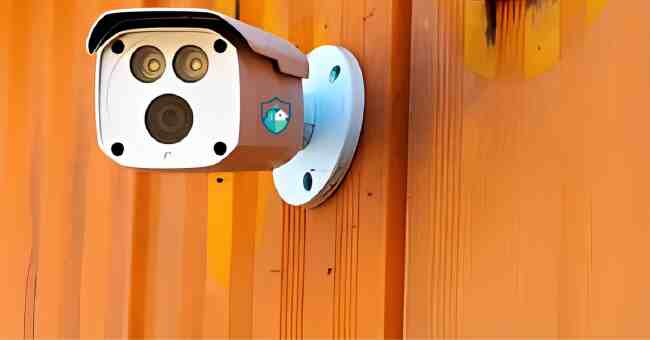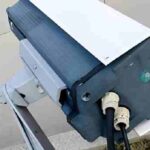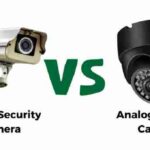Table of Contents
Have you ever wondered how to spot a fake security camera? Yes, As security cameras have become more prevalent, so have fake ones designed to deter crime on the cheap.
But fake surveillance can also create a false sense of security. That’s why it’s important to know how to discern real security cameras from fakes.
As my buddy recently learned with that phony camera above his doorbell, you can’t always trust those blinking lights and dark domes to be the real deal.
After doing some digging, I’ve come up with 12 tips to help you spot a fake security camera based on their physical and functional differences.
I’ll also cover some best practices on using dummy cams effectively and weigh the pros and cons of false security measures.
So read on to become a security camera sleuth!
Physical Differences Between Real and Fake Security Cameras
Your first clues to identifying real vs fake security cameras will be visual. Here are some of the physical attributes and design details that can set them apart:
Real Cameras Have Finer Details and Text
Real security cameras will often have branding text and finely-printed specs somewhere on the housing. For example, the model number, megapixel count, or manufacturer’s branding.
Fake cameras lack these finer details and will typically have very basic “security camera” text in large fonts. If it’s just a sticker slapped on a plastic bubble, it’s likely a fake.
Fake Cameras Are Made of Cheaper Materials
Real cameras are constructed from metal and sturdy plastics to withstand the elements.
Fake cameras will be made of cheaper materials like thin plastic or styrofoam. Knock gently on the housing to feel and hear the difference.
I recently saw a fake camera that was literally a bubble dome made of dollar store sticker labels! No question that one was phony.
Real Cameras Have Multiple Lenses and Sensors
Real security cameras have multiple small lenses and sensors for different functions – like IR night vision or motion sensing. Dummy cameras just have a single lens for show – it’s not actually capturing anything.
Real Cameras Have Proper Cabling and Wiring
Real wired cameras will have cables running into the camera housing to supply power and connectivity.
Fake cameras often just have dangling wires or cables that go nowhere. Tracing the cables to verify they connect to power and a recording system is a good way to confirm legitimacy.
| Real Camera Features | Fake Camera Features |
|---|---|
| Fine details and branding text | Basic “Security Camera” text |
| Sturdy metal/plastic housing | Cheap plastic bubble or foam housing |
| Multiple lenses and sensors | Single fake lens for show |
| Proper cabling and wiring | Dangling or no wires |
So when assessing a camera’s physical traits, focus in on materials, text, lenses, and wires to sniff out the fakes.
Next we’ll explore how to outsmart dummy cameras by testing their functionality.
Functional Differences Between Real and Fake Security Cameras
Even if a fake camera looks convincing enough at first glance, its lack of function will give it away.
Here are some ways to confirm whether or not a suspicious camera is the real deal:
Real Cameras Move and Can Pan/Tilt/Zoom
One giveaway that a camera is fake is if it remains completely static. Real PTZ security cameras can rotate a full 360 degrees on both horizontal and vertical axes to scan an whole area.
Fake cameras have no range of motion – once you spot one locked in place, the jig is up. Wave your hand and watch for any mechanical movement.
Real Cameras Have Blinking or Flashing LED Lights
Most real security cameras will have small LED indicator lights that periodically flash or blink to signify “on” status and activity. $1 junk security camera fakes remain fully lit at all times.
So if that camera staring you down has an unwavering red glow, it’s likely just a powerless decoy.
Real Cameras Connect to a Recording System
Real cameras are able to transmit video footage back to a recording system like a DVR or NVR. Fake security cameras have no connectivity and no capacity to record.
Follow cables to confirm they connect to downstream equipment. Check for network cables as well if it’s an IP camera.
Real Cameras Have Higher Video Quality and Resolution
The ultimate test is to examine the camera’s actual video quality. Real cameras capture high-resolution footage with smooth motion and crisp detail.
Fake cameras either display no image at all, or a distorted, grainy picture unworthy of true CCTV footage.
| Real Camera Functions | Fake Camera Limitations |
|---|---|
| Rotates 360 degrees | Remains static |
| Flashing/blinking LEDs | Steady glow LED |
| Connects to recording system | No wiring or connectivity |
| High-quality video | No image or grainy picture |
So by putting their functionality to the test, the lack of performance from fake cameras quickly reveals their deception.
Now let’s move on to properly implementing dummy cameras as part of your security strategy…
Where to Place Fake Security Cameras Effectively
Fake security cameras certainly have their purpose for deterring crime on a budget.
Here are a few tips for strategically positioning phony cameras:
Deter Crime by Placing Fake Cameras in Plain Sight
The whole point of dummy cameras is to get criminals thinking they’re on camera. So mount them prominently in plain view in places real cameras would be expected.
Having $3 decoy security cameras clearly visible from sidewalks, entryways, and parking lots makes it appear you have full surveillance coverage.
Use Fake Cameras to Complement Real Ones
Expand your real security camera coverage by filling in blind spots with a few fake ones. Criminals casing the location may think your eyes reach further than they actually do.
Just be sure the fakes closely match your real models so they blend in seamlessly.
Place Fake Cameras in Low-Risk, Low-Traffic Areas
Dummy security cameras are best suited for keeping watch over low-value areas with minimal foot traffic. For example, down a back alleyway or side entrance rarely used.
Avoid using fakes to monitor critical assets, high-traffic zones, or anywhere real security is essential. Their job is just deterrence.
Now that you know where to position dummy cameras convincingly, let’s discuss some serious downsides and risks of fake surveillance…
Liability Concerns and Risks of Using Fake Cameras
While imitation security cameras have their place, falsely implying full protection in risky areas can be downright dangerous and open you up to major liability issues.
For example, I recently heard about a mall that put up fake cameras in their parking garage, thinking it was an easy way to deter crimes like theft and assault.
But when a shopper was ultimately attacked in the garage and the police investigation revealed the “security cameras” were actually worthless fakes, the mall owners were sued and financially liable for the victim’s damages.
The false sense of security provided by those sham cameras directly contributed to the incident. Security theater can backfire badly when real criminals call your bluff.
In summary, here are some major drawbacks to weigh:
- Fake cameras can create a false sense of security and misplaced trust in the safety of an area.
- Fake cameras provide zero evidence if a crime does eventually occur on the property.
- Fake cameras may not deter more serious criminal elements like violent offenders.
So keep liability risks in mind and restrict phony cameras only to low-consequence areas. For anywhere truly high-risk, invest in the real deal!
Alright, let’s wrap this up with a full rundown of the pros and cons…
Pros and Cons of Fake Security Cameras
PROS:
- Inexpensive deterrent against minor property crimes like vandalism and theft.
- Can complement real camera systems by covering additional ground.
- Don’t require any wiring, connectivity, or monitoring systems.
CONS:
- Provide no actual footage or evidence if a crime occurs.
- May fail to deter more serious criminal offenders.
- Risk creating a false sense of security and misplaced trust.
- No ability to monitor or respond to criminal activity.
- Could lead to liability issues if improperly used in high-risk areas.
So in summary, dummy cameras are an affordable supplementary deterrent, but have serious limitations in functionality, deterrence value, liability, and evidence collection compared to real CCTV systems. Use judiciously.
How To Spot A Fake Security Camera? 12 Tips
Here are the 12 tips for identifying real vs. fake security cameras outlined in the blog post:
- Real cameras have finer details and text like model numbers and specifications. Fake cameras have basic “Security Camera” text.
- Real cameras are made of sturdy metal and plastic. Fake cameras are made from cheap materials like thin plastic.
- Real cameras have multiple smaller lenses and sensors. Fake cameras just have one for show.
- Real cameras have proper cabling and wiring. Fake cameras have dangling or no wires.
- Real cameras can pan/tilt/zoom. Fake cameras remain static.
- Real cameras have flashing LED lights. Fake cameras have a steady glow.
- Real cameras connect to a recording system. Fake cameras have no connectivity.
- Real cameras have high resolution video. Fake cameras have no image or grainy video.
- Place fake cameras prominently to deter crime.
- Use fake cameras to complement real ones and expand coverage.
- Only use fake cameras in low-risk, low-traffic areas.
- Fake cameras can create liability risks if improperly used in unsafe areas.
FAQs
Do Fake Security Cameras Have Lights?
Fake security cameras often have lights on them to appear more realistic, but they don’t function like real camera lights.
The lights on dummy cameras are typically steady glowing LEDs that are always on. They don’t blink or change brightness like a real camera that is actively sensing motion and recording footage.
So if you see a security camera with an unwavering red glow or lights that never change, it’s likely just a fake decoy.
Do Fake Security Cameras Have Wires?
Some fake security cameras will have wires coming out of them as part of the disguise.
But upon closer inspection, the wires don’t lead anywhere or connect to power and recording equipment like they would on a real camera.
Often the wires are simply dangling or even wrapped up neatly, showing they aren’t actually transmitting power and data like real security camera cabling would be.
So don’t be fooled by any loose wires – trace them to see if they genuinely connect to downstream systems.
Do Real Security Cameras Have Red Lights?
While it was more common in the past, most modern real security cameras do not have red lights on them.
The only lights typically seen on real cameras are small blinking LEDs to indicate active status.
However, many fake cameras have prominent unblinking red lights on them as a visual deterrent.
So steady red glows are a dead giveaway of a dummy unit meant to just look like a security camera. If you see bold red lights, it is almost certainly a fake.
Do Fake Home Security Cameras Work?
Fake home security cameras do not actually record or transmit video, so they do not work other than as a visual deterrent.
Their sole purpose is to look like real cameras to scare off potential intruders.
Some fake home cameras may have flashing lights or realistic housing to appear legitimate.
But they have no functioning camera components inside and lack wiring to connect to recording and monitoring systems.
For actual home protection, you need real security cameras connected to DVRs and alarm systems to both deter and capture criminal activity.
Do Stores Use Fake Cameras?
Many stores do use fake security cameras as an inexpensive supplementary deterrent against theft and vandalism.
Retail outlets may mount fake cameras in plain sight to make it appear the premises are under full surveillance.
However, most stores with high-value merchandise will also invest in real cameras to actually record evidence if crimes do occur.
They may use convincing fakes in lower-risk areas to avoid blank spots in coverage. But real cameras are still essential for serious asset protection.
Do Real Security Cameras Have Blinking Red Lights?
While steady red glows are associate with fakes, real security cameras will often have small blinking red or blue LED lights on them to signify active recording status.
However, the lights are very subtle – not the large, prominent indicators you see on dummy units.
So small flashing LEDs can help confirm legitimate recording functionality. But bold steady red lights are generally reserved for counterfeit security theater.
The blinking lights on real cameras won’t be obvious from a distance.
What Does A Fake Camera Look Like?
Fake cameras are designed to mimic the housing of real security cameras with dome bubbles or box cameras.
But upon closer inspection, they have cheaper materials, no finer details, unrealistic wiring, non-functional lenses, and obvious steady red lights. Lower resolution stickers and plastic lenses are common.
The goal with fake cameras is to appear real at a glance while lacking functionality under scrutiny. So examine cameras closely to spot those missing details that reveal their fakery.
Do Real Security Cameras Have Blinking Red Lights?
As mentioned earlier, while fake cameras have prominent steady red glows, real security cameras will usually have much smaller blinking red or blue LED lights.
These lights flicker to indicate the camera is active and recording footage.
However, the blinking functionality lights on real cameras are very subtle and not easily visible unless you are examining the camera up close.
Large, obvious steady red lights are generally a sign of a non-working fake camera.
Conclusion: Trust Your Instincts!
Hopefully these tips equip you to approach any security camera with a healthy degree of skepticism.
When in doubt, check for those finer details, test its functionality, and scope out the wiring. Your spidey senses will quickly detect any fishy fakes.
You can usually trust those gut reactions – if a camera seems off, it likely is. Unless it’s convincingly transmitting high-quality surveillance footage, it’s more “security theater” than airtight protection.
The bottom line is don’t let up on the criminal element with lax, fake security measures. Step up your real camera coverage for guaranteed safety and evidence.
But do sprinkle in some decoys in low-risk areas to get crooks scratching their heads.
Stay observant out there and deter wrongdoing without getting fooled yourself. Let me know if you come across any other creative fake camera tests!




